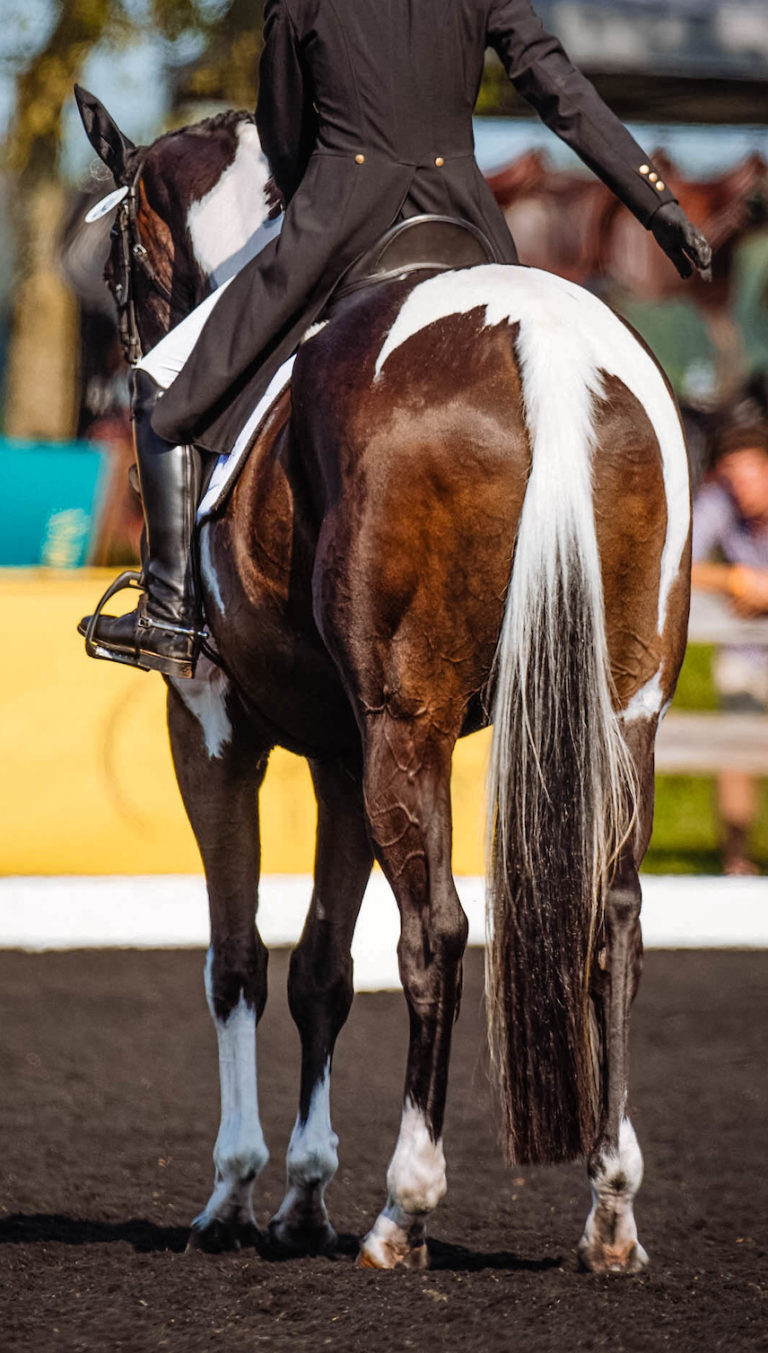The photograph below shows Tiané Coetzee on Callaho Lucera, an 8-year-old warmblood mare.

The photo is taken in the right lead canter. The photographer caught the “uphill” moment, and it shows a good forward reach of the inside hind leg under the center of the body. Lucera looks balanced and supple with a swinging tail and a concentrated expression with her ears directed toward Tiané, clearly listening to the rider. I like the connection and the slightly open frame for the elementary level. Asking the horse too early to be rounder, especially in canter, can kill the uphill and forward movement.
My first thought looking at this picture was that here is a rider with a lot of feeling and aiming for the most harmonious partnership with her horse.
Tiané is riding Lucera with the same concentration that was seen on the horse’s expression, and it looks like the two of them are in their own world. As important as concentration is in a test, over-concentrating can lead to looking down and a slight forward position of the upper body, as shown in the picture. Looking proudly up and over her horse’s ears can help open the shoulders and give the upper body more presence and stability during the canter. Tiané is not bending her head down, but even the eye movement triggers the direction of our body muscles.
Try the following: sit upright on a chair and move only your eyes to the right. Then move your eyes again to the right and allow the head to turn to the right, too. You will feel this is possible in an easy and fluent way. Now try to move your eyes again to the right but turn your head to the left. This feels strange, looks weird and needs some concentration.
Next, do the same starting upright, looking down only with your eyes. Then look with the eyes down and bend your neck down. After this, look up first only with the eyes; then follow the eyes softly with your head and neck up. When changing this movement to opposite directions, eyes down and head up versus eyes up and head down, you may even feel a little dizzy. Our reflexes connect the eye movement automatically with the movement of the first segment of the spine (occipital joint). Any stiffness or stress there has a huge impact on our balance and reflexes, both of which we need in riding.
Therefore, “look where you are going” is not only good advice, but also a key element for a supple and balanced seat.
Tiané’s leg position shows a little outside rotation of her knee and lower leg, with the toes pointing more out. This is a common issue in canter as the impulsion of the movement often causes the leg to compensate. Here it is important to understand that the cause for this open leg position is seldom the leg itself. The complex balance system of the whole body must be addressed.
In canter, the danger of shifting the weight to the outside is high. If I look at the picture very closely, I notice not only the outside rotation of her right leg, but also a slight tension in her inside elbow. This can be caused by merely having more weight on the outside seat bone. To help this situation, I would advise Tiané to ride in canter with her reins in the outside hand and reach towards the sky with her inside hand, palm facing up. Reaching up will help her shift her weight forward to the inside seat bone and lengthen her side, which helps prevent collapsing in the side. Once her upper body is long and upright, her hip joint becomes freer, and her leg does not need to compensate (outside rotation).
Another tool is to canter standing up in both stirrups while maintaining the upright upper body as much as possible. This “Standing-Dressage” seat while cantering will make her feel how to ground her leg position better to the stirrups and allow a more supple and independent leg when sitting down into the saddle again.
Both of these exercises, reaching up with the inside hand and the standing up dressage position, will give Tiané a better idea of how lengthening her upper body can make her seat more stable while maintaining elasticity and suppleness. Here, too, she will notice how much “looking in the right direction” will help her ability to balance her body better and allow her shoulders and chest to open. It will add some more security, joy and pride to her concentrated and feeling seat.
A tiny detail I noticed is that Tiané is holding the whip on the top end of the handle. It would be better to allow the top of the whip to look out of the hand a bit. Then the whip is more balanced in the hand and needs less grip of her wrist to hold. This can help her relax her wrist and elbow more. I personally use a rubber martingale stopper and slide it over the whip. That allows the whip to rest in a balanced point with the stopper above my hand, and my fingers do not need to hold it.
Hoping Tiané and Lucera can implement these tools into their riding and continue with feeling and harmony exploring the world of dressage.

Susanne von Dietze is a leader in equestrian biomechanics. A physiotherapist, licensed Trainer A instructor and judge for dressage and show jumping, she gives lectures and seminars throughout the world, including at the prestigious German Riding Academy in Warendorf. She is a native of Germany and now lives with her husband and three children in Israel, where she competes at the international level. She is the author of two books on the biomechanics of riding: Balance in Movement and Rider and Horse, Back to Back.
This article originally appeared in the Summer 2021 issue of Practical Horseman.











